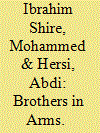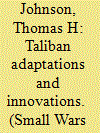| Srl | Item |
| 1 |
ID:
188031


|
|
|
|
|
| Summary/Abstract |
Globally, the spread and use of suicide bombing attacks have become a regular occurrence. Suicide terrorism literature focuses primarily on conventional suicide bombing attacks. However, a growing trend has been observed in the adoption of complex suicide attacks. Using Al-Shabaab as a case study, this paper investigates the phenomenon of complex suicide attacks. We explore the tactical differences of complex suicide attacks vis-à-vis simple attacks in terms of its target goal, discriminative lethality, and delivery method. The paper relies on a uniquely constructed dataset of the group’s suicide operations, employing a variety of data collection techniques. The findings reveal that, inter alia, complex suicide attacks reduce civilian casualties compared to simple suicide attacks. Contrary to the group’s intent and official guidelines to target foreign entities; findings illustrate that domestic targets bear the brunt of most complex suicide attacks. These findings have the potential to contribute to counter-terrorism strategies and be adopted by concerned states in order to effectively protect significant loss of lives and destruction of property resulting from suicide terrorism.
|
|
|
|
|
|
|
|
|
|
|
|
|
|
|
|
| 2 |
ID:
119497


|
|
|
|
|
| Publication |
2013.
|
| Summary/Abstract |
Since 1978, insurgents in Afghanistan have endured a state of constant conflict, facing two occupying forces that have fielded modernized, highly capable militaries with a multitude of numerical and technological advantages over them. The asymmetry of these conflicts drove a rapid cycle of adaptation and innovation on the part of the insurgents that continues today. The Taliban way of war and approach to governance focuses on turning populations against political weakness and fielding simple and effective governance at the local and provincial levels. The Taliban has proven to be a highly adaptive, innovative, and resilient organization, drawing on tactics from conflicts in Iraq, Pakistan, and their own experience in Afghanistan to fight an effective and enduring defensive jihad. The introduction of improvised explosive devices, suicide bombers, and more recently a rising rate of assassinations all demonstrate the Taliban's ability to adapt tactically and innovate at the strategic level. These innovations are even more significant when one considers the cultural, social, and ideological barriers to change and how the Taliban overcame those barriers to include in their arsenal formerly taboo actions, such as suicide bombing. Understanding the innovation shown by insurgents in Afghanistan provides critical insights into the conflict the US-led coalition faces today and how it may be fought tomorrow.
|
|
|
|
|
|
|
|
|
|
|
|
|
|
|
|